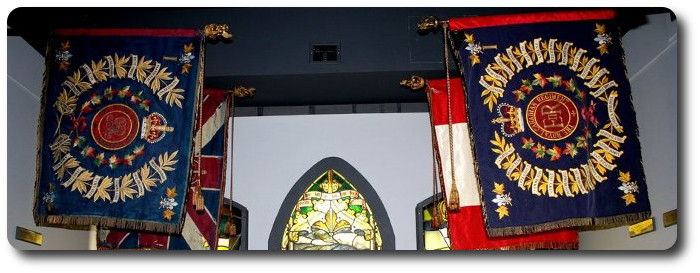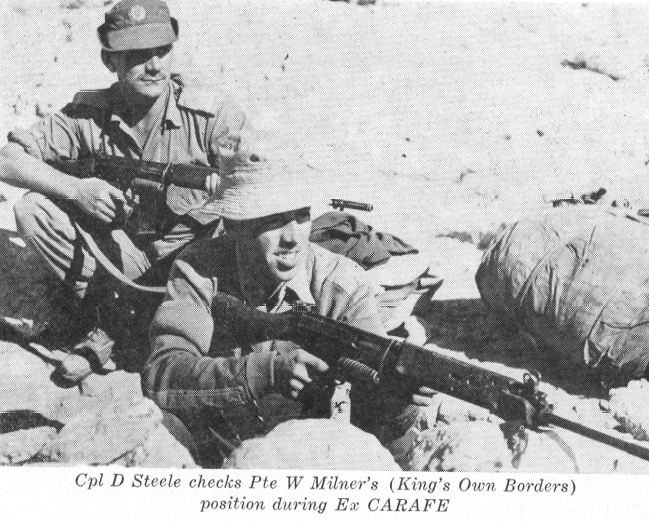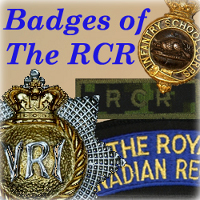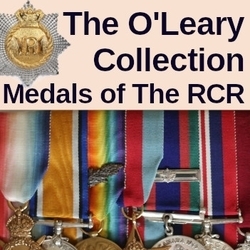
Researching The Royal Canadian Regiment
LIBYA 1968
Lt D.M. Ferguson
The Connecting File, 1968
This year 1 RCR sent two 8 man contingents to train with the British Army in the vast Libyan desert. The aim of this training was to indoctrinate the Canadians in the art of desert warfare, in all phases of war.
On 1 October 68 the first group left CFB Trenton airport in 55° temperature to arrive in Nicosia, Cyprus on 2 October with a temperature of 76° F. The group included Lt Don Ferguson, Sgts Vic Rettenbacher, Ted Pope, Ralph Brannon and Cpls Phil Abboud, Danny Boudreau, Doug Steele and Ron Tomes. We joined the 1st Battalion The King's Own Border Regiment stationed in Episkopi, Cyprus on 3 October and rested that night before meeting LCol Hardy the following morning. We were then shipped out to the companies to assume active positions in each company (holding the normal command positions for our rank).
Until 25 October we trained with the British, and helped prepare for the move to Libya. Such subjects as instruction on the sun compass, kit checks, documentation, exchange of currency, and lectures to the troops on all phases of war, were covered in this period of time.
The battalion was airlifted by Argosy aircraft (except for an advance party which went by ship) and was on the ground complete in Libya by 30 October. Our first day in the desert saw sunny skies, 80° temperatures, and only a slight breeze. The terrain was flat, hard sand, which supported small, "tumble-weed" like bushes and off in the distance we could see a prominent line of "gebbles", (hill features). Exercise "Carafe", which was to last from 28 October until 21 November, had begun.
The 3 weeks to follow saw the battalion undergoing rigorous night and day training. The nights were getting cool (about 45° F) and the days were still sunny, but the winds would whip up to about 40 mph during the afternoon, creating small isolated "ghiblis" (sand storms).
The scope of the training included advance to contact, withdrawals, patrols, field firing and sun compass navigation. The companies worked out of a base camp called St. Barbara which was situated 30 miles south of Timimi (Timimi being 60 miles west of Tobruk).
Each company managed to fit one day of rest and recuperation into their training schedule. Most of us headed for Tobruk, or Cyrenaica, to pick up souvenirs. The others went for a swim at a Base Camp set up on a beach in Bombah, about 30 miles west of Timimi.
On 16 November the battalion exercise started. Dodging live WW II minefields, which in most cases were not marked, the battalion moved 25 miles by foot and vehicle to take up a defensive position. On the first night fighting and recce patrols of up to 20 and 30 miles were despatched. On the second night a vehicle mounted withdrawal. During the daylight hours the battalion fought off light armour attacks on its position. The exercise ended up with a battalion advance to contact which "eliminated the small pockets of resistance left by the enemy".
On 20 November the first group was flying back to Cyprus to await a flight back to Canada. At the same time the second 1 RCR group had docked at Tobruk, and had their first glimpse of their "home" for the next 4 weeks.
Windswept sand and cold damp nights greeted the second group to the Libyan desert, where they were attached to the 1st Bn the Lancashire Regiment (PWV) normally stationed in Malta. The group consisted of Lts Walt Holmes, Tom Leitch, Sgt Benny Bendell, Bill Norman, Cpls Dick Forbes, Joe Kelly, Mike Molloy and Fred White. The exercise was called "Nivea", a desert oriented exercise, which lasted from 20 November to 16 December 1968.
Tobruk, the war-torn city of World War II was the first close up view the second group got of Libya. Bombed out structures were still in evidence as they docked at Tobruk harbour early on the morning of 20 November 68. The city has been rebuilt around these shattered buildings leaving them to destruction by the elements -wind, rain and sand.
They off-loaded the cargo from the British Landing Ship Tank, which they had the misfortune of spending four days aboard at sea. Having spent about five hours marshalling the vehicles and equipment they then set out on a one hundred and twenty mile journey into the desert, first heading west to Timimi and then south into the desert, where they were to spend the next month in desert indoctrination.
Mixed feelings prevailed upon arrival at the destination, Ras el Albah, about twenty-five miles deep in the desert. The traditional picture of the desert, endless rolling sand dunes, was not evident. This desert was composed of vast areas of flat waste land dotted with sloughs and camel grass. The flats occasionally rise to low rocky hills, which at times spread over large areas.
After one night in the Battalion Base Camp at Ras, they moved into Phase One of Exercise "Nivea", which was carried out in the area of Chatham, another twenty-five miles into the desert. The group was attached to Support Company (B Coy) for a period of 1 week. This week was devoted to mortar and anti-tank field firing and some sun compass indoctrination. This period was particularly beneficial to the group as it gave them a chance to get well acclimatized to the desert and to the British Army.
Phase Two of the exercise was a two-week company controlled training period. The Canadians were divided for the first time on the trip. Three went to a rifle company, "A" Company; two to the enemy, "D" Company and three remained with "Sp" Company. The training in this period encompassed field firing with all weapons, including two-inch mortars, dry tactical training and a variety of night exercises. This training was designed to prepare them for phase three, which was nicknamed Exercise "Timimi Hunt".
Exercise "Timimi Hunt" was a five-day battalion effort designed to exercise a self-contained battalion in all phases of war in a desert environment. Points emphasized were advance to contact-mounted and dismounted, defence by day and night, and search and destroy operations. Although it was desert terrain, the basic British tactics were very similar to Canadian tactics in a mounted and dismounted role.
The exercise proved to be a very valuable experience to all of us Canadians. Although the unbearable heat of the desert was lacking during the stay, we became aware of the problems of navigation, re-supply and maintenance of morale in a desert operation. We had the opportunity to view another army in action, an army which had recently seen action in Aden. Last but not least, we made many new acquaintances whom we will long remember, and acquired new war stories which will serve us in good stead at the bar in years to come.



